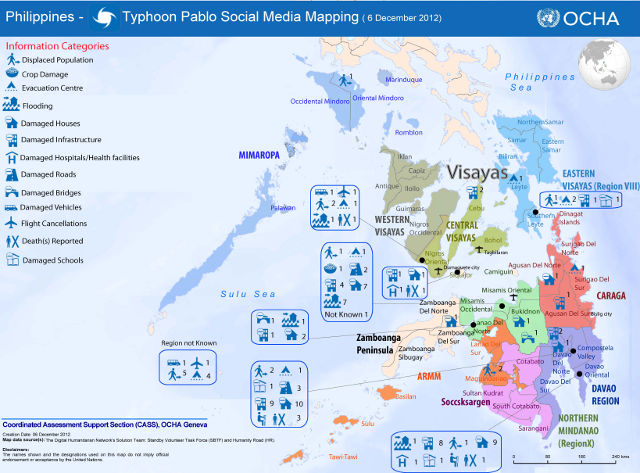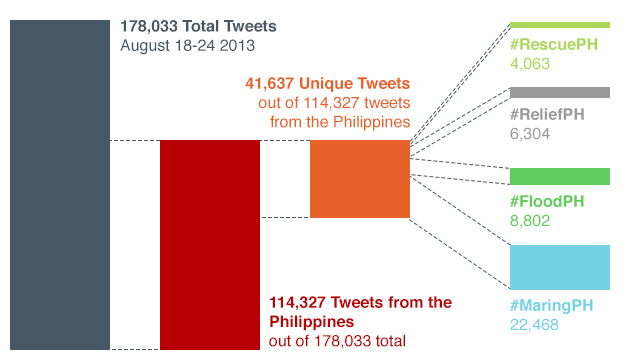SUMMARY
This is AI generated summarization, which may have errors. For context, always refer to the full article.

MANILA, Philippines – Social media is the new frontier of Disaster Risk Reduction and Response Management (DRRM) in the Philippines. Unfortunately, we’re still not very good at it.
Back in 2012 when Typhoon Pablo (Bopha) hit the Philippines, netizens initiated unified hashtags which the Philippine government later picked up.
The Twitter account of the Official Gazette (@govph) and Presidential Communications Development and Strategic Planning Office (@PCDSPO) adopted the hashtags #RescuePH and #ReliefPH to coordinate rescue and relief operations after Pablo.
Because of the good quality of disaster information coming from Philippines Twitter, the United Nations Office for the Coordination of Human Affairs (UNOCHA), through the Digital Humanitarian Network (DHN) came up with an official crisis map of Typhoon Pablo sourced from social media information. The first of its kind at the time.

Since then, the use of #RescuePH, #ReliefPH, and #FloodPH has become second nature to Filipino netizens during times of disaster. However, the continued use of these hashtags also resulted in a continued rise in the volume of social media information.
Habagat 2013 and MaringPH
The southwest monsoon enhanced by Tropical Storm Maring (Trami) brought massive rainfall and floods to the northern provinces of Luzon and Metro Manila. It also brought a massive amount of social media information.
The hashtags #MaringPH, #FloodPH, #RescuePH, and #ReliefPH produced 178,033 tweets from August 18 to August 24, 2013 according to a Radian6 scan.

Out of the 178,033 tweets, only 114,327 or 64% were from the Philippines. The overseas tweets were mostly from OFWs primarily in the United States, tweeting the news and checking on relatives.
Out of the 114,327 tweets coming from the Philippines, 72,690 or 63% were retweets. This means that only 37% or 41,637 were unique tweets. This doesn’t necessarily mean that all 41,637 tweets were about unique topics. Most were about similar events, but from unique Twitter users or from the same users who talked about different events.
Of the 41,637 unique tweets, 22,468 contained #MaringPH, 8,802 contained #FloodPH, 6,304 contained #ReliefPH and only 4,063 contained #RescuePH.
Most of the 22,468 tweets about #MaringPH were about storm updates such as landfall, amount of rain, rainfall level warnings and netizens’ reactions to the storm.
The #FloodPH tweets were flood reports mainly from the Metro Manila Development Authority (MMDA) and netizen reports.
The top #RescuePH and #ReliefPH tweets were mostly about informational posts about the hashtags and hashtag abuse warnings, instead of tweets requesting for rescue.
If you or someone you know needs to be rescued, pls use the hashtag #rescuePH so the gov’t. designated rescuers can find you #MaringPH
— Twitter Philippines (@twitter_ph) August 18, 2013
To those using #rescueph pls include name, COMPLETE address & contact info. Try not to use hashtag for other things except rescue requests
— Manuel L. Quezon III (@mlq3) August 19, 2013
#ReliefPH did better because the top tweets were actually calls for volunteers, relief goods and relief operations.
We can cook roughly 1500 cups of rice an hour. Please send canned goods, rice and reusable packaging material to Enderun. #ReliefPH
— Enderun Colleges (@EnderunColleges) August 20, 2013
Everyone, pls RT – Donate to RED CROSS via SMS, text RED <space> AMOUNT send it to 2899 (Globe) & 4143 (Smart) #AlabNgPuso #reliefPH #UNITAS
— #ABRA2013 (@ABRAOFFICIAL) August 21, 2013
Out of the 41,637 unique tweets during #MaringPH, only 3,053 were geotagged. This means that only 3,053 tweets contained the exact latitude and longitude location where the tweet was sent. This is very advantageous for rescue operations, because responders can map the exact location of a person needing rescue.
Out of the 3,053 geotagged tweets, only 192 tweets used the #RescuePH hashtag. Unfortunately, even the 192 geotagged tweets weren’t all about requests for rescue.
So from 178,033 tweets during the rains and flooding caused by the southwest monsoon enhanced by Tropical Storm Maring, only 4,063 had the #RescuePH hashtag and only 192 had exact location information.
OdettePH
On Monday, Sept 23, 2013, monsoon rains again caused flooding in Metro Manila and Northern Luzon, especially Olongapo.
Surprisingly there were only 3,295 tweets with the following hashtags: #Habagat, #ReliefPH, #RescuePH, #OdettePH and #FloodPH. 1,137 contained #FloodPH, 1,005 contained #Habagat, 722 contained #RescuePH and 431 contained #ReliefPH.
2,390 tweets from the 3,295 were from the Philippines, the rest came from abroad, primarily from the US. Out of the 2,390 tweets from the Philippines, only 1,072 were unique. The rest were retweets.
575 of the unique tweets contained #Habagat, 262 contained #FloodPH, 132 contained #RescuePH, and 103 contained #ReliefPH.
Out of the 1,072 tweets, only 85 were geotagged – and out of the 85, only 5 contained the hashtag #RescuePH.
All 5 geotagged #RescuePH tweets weren’t even calls for rescue.
Unfortunately, the very thin amount of social media information was caused by the improper use of the hashtags #FloodPH, #RescuePH and #ReliefPH. A lot of the Olongapo flood tweets did not even contain the hashtag #FloodPH.
Do your part and reduce the noise
The habagat enhanced by Maring bombarded us with too much social media information, while the monsoon right after Odette gave us too little. Here are some tips to be a better netizen during disasters so that responders monitoring social media get more useful information.
1. Use the hashtags properly. Easy to remember but hard to put in practice.
#[storm name]PH is for information about the storm like storm signal level, path, rainfall level.
#RescuePH is only for rescue or assistance requests.
#ReliefPH is for donations, relief center locations and relief operations information.
#FloodPH is for flood updates.
Try to use only one hashtag per tweet, or at most the storm hashtag plus only #RescuePH or #ReliefPH or #FloodPH. Using all the hashtags in a single tweet will pollute the feeds of responders monitoring social media.
Here’s an example of a good tweet with very useful information:
RT!!! 1465 Zobel Roxas corner Amatista Street, Singalong, Manila. 2 Elderlies and helpers stuck inside van NEED RESCUING #RescuePH
— Kata Nava (@kathnava) August 20, 2013
2. Be mindful of what you retweet
The most retweeted tweets during MaringPH were tweets warning about the abuse of the hashtags #RescuePH, #ReliefPH, and #FloodPH. It’s good that information like that is being spread to everyone online, but unfortunately, every retweet will also appear on the feeds of the responders monitoring.
Try to avoid retweeting tweets of the same topic or message. Once is enough since a lot of netizens will most likely be retweeting as well.
Even if you’re just spreading the word to not abuse the hashtags, you already are.
3. Be specific
If you’re requesting for rescue through #RescuePH, be specific with your location and try to tag the government agency concerned, or a media group. You can also give details like your situation and number of victims if the character count permits. Even better if you can…
4. Turn on geo-location if you know you’re in a vulnerable area
Geotagging will help those monitoring social media to map your exact location. This is very advantageous, especially for responders, because the tweet can be accurately plotted on a map.
Be a hero
Remember, “Bawat patak ng text, or tweet, or post sa Facebook ay maaaring maging agos ng impormasyon na maghahanda sa ating harapin ang hamon ng panahon.” (Every text or tweet or post on Facebook could be a stream of information that could prepare us to face the weather challenge.)
We still have a long way to go before we harness the full potential of social media for disaster risk reduction and response management. There is just too much information which no single agency can make sense of. Not even the government.
That’s why MovePH, the citizen engagement arm of Rappler launched Project Agos – an initiative to bring together the Government, the private sector and citizens to address climate change and disasters.
Part of Project Agos is a tool which automatically scans social media, sms and web, and extracts the most relevant disaster information. This information is then presented in an intuitive interface customized for the government, responders and local government units, and citizens.
Project Agos gives citizens a bigger role during disasters. You’re no longer just spreading information, but you’re providing relevant information to those who can act on it.
Just by watching what you tweet and choosing what you retweet, you can help in your own little way. You can be a hero. – Rappler.com
Add a comment
How does this make you feel?





There are no comments yet. Add your comment to start the conversation.